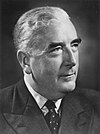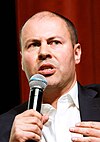Division of Kooyong
| Kooyong Australian House of Representatives Division | |
|---|---|
 Division of Kooyong in Victoria, as of the 2019 federal election. | |
| Created | 1901 |
| MP | Josh Frydenberg |
| Party | Liberal |
| Namesake | Kooyong, Victoria |
| Electors | 108,424 (2019) |
| Area | 55 km2 (21.2 sq mi) |
| Demographic | Inner Metropolitan |
The Division of Kooyong is an Australian Electoral Division for the Australian House of Representatives in the state of Victoria, which covers an area of approximately 55 km2 (21 sq mi) in the inner-east suburbs of Melbourne. It is currently based on Kew, and also includes Balwyn, Canterbury, Deepdene, Hawthorn, Mont Albert and Mont Albert North; and parts of Camberwell, Glen Iris, Hawthorn East and Surrey Hills.
Since the 2010 election, Josh Frydenberg, the federal Treasurer and current Deputy Leader of the Liberal Party, has been the member for the Division, following the retirement of Petro Georgiou.
History[]

The Division was proclaimed in 1900, and was one of the original 65 divisions to be contested at the first Federal election.
Kooyong has been held by the Liberal Party of Australia and its conservative predecessors for its entire existence, apart from 1921 to 1925, when John Latham successfully ran as a "Liberal", mainly on the platform of removing Billy Hughes as Prime Minister. With Hughes' resignation in 1923, Latham joined the governing Nationalist Party, and remained a member till his resignation from the seat and his elevation to the High Court. It is one of two original electorates in Victoria to have never been won by the Australian Labor Party, the other being Gippsland. For decades, it has been one of the safest Coalition seats in metropolitan Australia. Even during Labor's landslide victory in 1943, Menzies won comfortably with 62.5 percent of the two-party-preferred vote.
The seat's best-known member was Sir Robert Menzies, the longest-serving Prime Minister of Australia. From 1922 to 1994, it was held by only three members, all of whom went on to lead the non-Labor forces in Parliament – former Opposition Leader and future Chief Justice John Latham, Menzies, and former Opposition Leader Andrew Peacock.
Peacock's successor, high-profile Liberal backbencher Petro Georgiou, saw off a challenge from Josh Frydenberg for Liberal Party preselection in April 2006. On 22 November 2008, Georgiou announced his retirement at the next federal election.[2] Frydenberg won preselection as the Liberal Party's candidate for the seat for the 2010 election and won, despite a small swing against him.
In 2019, high-profile Greens candidate Julian Burnside received the highest two-party preferred vote against the Liberals or their predecessors in 90 years, at 44.3%. The Liberals had anticipated a strong contest and doubled their campaign funding to Kooyong earlier in the year, from $500,000 to $1 million.[3] Frydenberg retained the seat, despite suffering a significant negative swing of 8.81% and the Liberal Party receiving its lowest first preference vote in the electorate in 76 years. It was also only the second time in 76 years that the major non-Labor party did not win the seat outright on the first count. The swing was actually large enough to drop the Liberal margin in a "traditional" two-party contest with Labor to 6.8 percent, the closest margin between the parties in decades. Although the Liberal Party won in the majority of booths, the Greens had the highest primary vote in three booths (Melbourne, Glenferrie and Glenferrie Central) and won in two-party preferred terms in 10 of the booths.
Name[]
The Division is named after the suburb of Kooyong, on which it was originally based. However, the suburb of Kooyong has not been in its namesake electorate for some time, being instead in neighbouring Higgins. Nonetheless, the seat has retained the name of Kooyong, primarily because the Australian Electoral Commission's guidelines on electoral redistributions require it to preserve the names of original electorates where possible.[4]
Members[]
| Image | Member | Party | Term | Notes | |
|---|---|---|---|---|---|

|
William Knox (1850–1913) |
Free Trade | 29 March 1901 – 1906 |
Previously a member of the Victorian Legislative Council. Resigned due to ill health | |
| Anti-Socialist | 1906 – 26 May 1909 | ||||
| Commonwealth Liberal | 26 May 1909 – 26 July 1910 | ||||

|
Sir Robert Best (1856–1946) |
Commonwealth Liberal | 24 August 1910 – 17 February 1917 |
Previously a member of the Senate. Lost seat | |
| Nationalist | 17 February 1917 – 16 December 1922 | ||||

|
John Latham (1877–1964) |
Liberal Union | 16 December 1922 – 1925 |
Served as minister under Bruce and Lyons. Served as Opposition Leader from 1929 to 1931. Retired. Later appointed Chief Justice of Australia | |
| Nationalist | 1925 – 7 May 1931 | ||||
| United Australia | 7 May 1931 – 7 August 1934 | ||||

|
(Sir) Robert Menzies (1894–1978) |
United Australia | 15 September 1934 – 21 February 1945 |
Previously held the Victorian Legislative Assembly seat of Nunawading. Served as minister under Lyons, Page and Fadden. Served as Opposition Leader from 1943 to 1949. Served as Prime Minister from 1939 to 1941, and 1949 to 1966. Resigned in order to retire from politics | |
| Liberal | 21 February 1945 – 17 February 1966 | ||||

|
Andrew Peacock (1939–2021) |
Liberal | 2 April 1966 – 16 August 1994 |
Served as minister under Gorton, McMahon and Fraser. Served as Opposition Leader from 1983 to 1985, and from 1989 to 1990. Resigned in order to retire from politics | |

|
Petro Georgiou (1947–) |
Liberal | 19 November 1994 – 19 July 2010 |
Retired | |

|
Josh Frydenberg (1971–) |
Liberal | 21 August 2010 – present |
Served as minister under Turnbull. Incumbent. Currently a minister under Morrison |
Election results[]
| Party | Candidate | Votes | % | ±% | |
|---|---|---|---|---|---|
| Liberal | Josh Frydenberg | 48,928 | 49.41 | −8.24 | |
| Greens | Julian Burnside | 21,035 | 21.24 | +2.65 | |
| Labor | Jana Stewart | 16,666 | 16.83 | −3.70 | |
| Independent | Oliver Yates | 8,890 | 8.98 | +8.98 | |
| United Australia | Steven D'Elia | 1,185 | 1.20 | +1.20 | |
| Animal Justice | Davina Hinkley | 1,117 | 1.13 | +1.00 | |
| Independent | Bill Chandler | 669 | 0.68 | +0.68 | |
| Independent | Angelina Zubac | 539 | 0.54 | −2.32 | |
| Total formal votes | 99,029 | 97.03 | −0.97 | ||
| Informal votes | 3,033 | 2.97 | +0.97 | ||
| Turnout | 102,062 | 94.14 | +0.48 | ||
| Two-party-preferred result | |||||
| Liberal | Josh Frydenberg | 56,127 | 56.68 | −6.14 | |
| Labor | Jana Stewart | 42,902 | 43.32 | +6.14 | |
| Two-candidate-preferred result | |||||
| Liberal | Josh Frydenberg | 55,159 | 55.70 | −7.64 | |
| Greens | Julian Burnside | 43,870 | 44.30 | +44.30 | |
| Liberal hold | Swing | N/A | |||
References[]
- ^ Profile of the electoral division of Kooyong (Vic)[1] Retrieved 1 November 2019.
- ^ The Age Online (2008). Georgiou, the party conscience, to quit. Retrieved 22 November 2008.
- ^ "Libs to burn $1m on Frydenberg". The Australian. 5 March 2019. Retrieved 15 December 2019.
- ^ "Guidelines for naming divisions". Australian Electoral Commission. 20 July 2011. Retrieved 30 March 2013.
- ^ Kooyong, VIC, Tally Room 2019, Australian Electoral Commission.
External links[]
- Electoral divisions of Australia
- Constituencies established in 1901
- 1901 establishments in Australia
